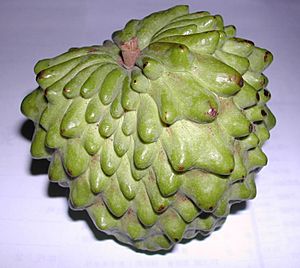Atemoya facts for kids
Quick facts for kids Atemoya |
|
|---|---|
 |
|
| Scientific classification | |
| Genus: |
Annona
|
| Species: |
× atemoya
|
The atemoya is a special fruit. It's a hybrid of two other fruits: the sugar-apple (Annona squamosa) and the cherimoya (Annona cherimola). Both of these parent fruits grow naturally in the warm, tropical parts of America.
This tasty fruit is very popular in many countries. In Taiwan, people call it the "pineapple sugar apple." Sometimes, people mistakenly think it's a mix of sugar-apple and pineapple. In Cuba, it's known as anón, and in Venezuela, it's called chirimorinon. In Israel and Lebanon, the fruit is named achta. In Tanzania, it's called stafeli dogo, which means "mini soursop".
Atemoya farming has grown a lot. In Brazil, about 1,200 hectares of atemoya were grown in 2011. In Taiwan, the growing area reached over 2,856 hectares in 2020. Most of this farming happens in Taitung County.
Atemoya fruits are usually shaped like a heart or are round. They have pale-green, bumpy skin that can bruise easily. Near the stem, the skin is bumpy, similar to a sugar-apple. But towards the bottom, it becomes smoother, like a cherimoya.
The inside of the fruit is not divided into segments, which is more like a cherimoya. It's very juicy and smooth. The taste is slightly sweet and a little tart, like a piña colada. It also has a hint of vanilla flavor, which comes from its sugar-apple parent. Be careful though, because many inedible, black seeds are found throughout the flesh. When the fruit is ripe, you can scoop the yummy flesh out of its shell and enjoy it chilled.
How Atemoya Was Created
The atemoya (Annona cherimola × squamosa) was made by crossing the cherimoya (A. cherimola) with the sugar-apple (A. squamosa). Sometimes, these natural hybrids were found growing in places like Venezuela. Also, during the 1930s and 1940s, some accidental hybrids appeared in Israel where sugar-apple and cherimoya trees grew close together.
The first planned cross was made in 1908 by P.J. Wester. He was a plant expert at a special lab in Miami, Florida, run by the USDA. The fruits that came from this cross were much better than the sugar-apple. They were given the name "atemoya." This name combines ate, an old Mexican word for sugar-apple, and "moya" from cherimoya.
Later, in 1917, another expert named Edward Simmons successfully grew atemoya hybrids in Miami. These plants were tough and survived when the temperature dropped to about -3 degrees Celsius (26.5 degrees Fahrenheit). This showed that atemoya got its hardiness from its cherimoya parent.
Pollination
Atemoya trees, like other Annona trees, have special flowers. Their flowers have both male and female parts, but they don't open at the same time. This means it's rare for a flower to pollinate itself. Because of this, people often help the plants by doing hand pollination. This usually makes sure the fruits are of the best quality.
Some types of atemoya, like the 'Geffner' variety, can produce good fruit without hand pollination. The 'Bradley' variety also produces decent crops without hand pollination, but its fruits sometimes split open on the tree. If an atemoya fruit is misshapen or only grows on one side, it's often because it didn't get enough pollination.
An atemoya flower opens in its female stage in the afternoon, usually between 2:00 and 4:00 pm. The next afternoon, between 3:00 pm and 5:00 pm, the same flower changes to its male stage.
Cultivars
Different types of atemoya are called cultivars. Here are a couple of popular ones:
Gefner
- The 'Gefner' is a very productive type from Israel.
- It grows very well in Florida and doesn't need hand pollination there.
- It produces good quality fruits that can weigh up to 450 grams.
- The fruit's sections are narrow and pointed.
- The inside flesh is white, juicy, and firm. It's so firm that a spoon might not easily go through it.
- When you chew it, it feels a bit like chewing gum.
- This fruit is very sweet, reaching 25 ºBx (a measure of sweetness).
Thompson
- The 'Thompson' cultivar has features that are a mix between the sugar-apple and cherimoya.
- Its sections are narrow and stick out near the stem.
- From the middle to the tip of the fruit, the sections are smoother and larger, but still well-joined.
- The inside flesh is white, juicy, and soft, with a creamy texture. A spoon can easily go through it when you eat it.
- This fruit is also very sweet, reaching 25 ºBx.
- It's a good choice for growing because it produces well and the fruits are nicely shaped when pollination is good.
- The plants are strong and quite resistant to common plant diseases.
- Sometimes, fruits that look like the 'Pink's Mammoth' cultivar appear on 'Thompson' plants, which can be confusing.
- This is the most widely grown atemoya type in Brazil.
See also
 In Spanish: Atemoya para niños
In Spanish: Atemoya para niños

